Questions with Answers, Solution | Geometry | Chapter 5 | 8th Maths - Exercise 5.4 (Construction of Quadrilaterals and Trapeziums) | 8th Maths : Chapter 5 : Geometry
Chapter: 8th Maths : Chapter 5 : Geometry
Exercise 5.4 (Construction of Quadrilaterals and Trapeziums)
Exercise
5.4
I. Construct the following quadrilaterals
with the given measurements and also find their area.
1. ABCD, AB = 5 cm, BC = 4.5 cm, CD = 3.8
cm, DA = 4.4 cm and AC= 6.2 cm.
Solution:
Given :
AB = 5 cm, BC = 4.5 cm, CD = 3.8 cm, DA = 4.4 cm, AC= 6.2
cm
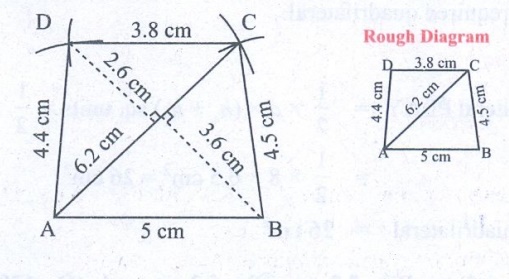
Steps:
1. Draw a line segment AB = 5 cm
2. With A and B as centers drawn arcs of radii 6.2 cm and 4.5cm
respectively and let them cut at C.
3. Joined AC and BC.
4. With A and C as centrers drawn arcs of radii 4.4cm and 3.8 cm
respectively and let them at D.
5. Joined AD and CD.
6. ABCD is the required quadrilateral.
Calculation of Area:
Area of the quadrilateral ABCD  = 1/2 × d × (h1
+ h2) sq. units
= 1/2 × d × (h1
+ h2) sq. units
= 1/2 × 6.2 × (2.6 + 3.6) cm2 = 3.1 × 6.2 = 19.22 cm2
2. PLAY, PL= 7 cm, LA = 6 cm, AY= 6 cm, PA = 8 cm and LY = 7 cm.
Solution:
Given
PL = 7 cm, LA = 6 cm, AY= 6 cm, PA = 8 cm, LY = 7 cm

Steps:
1. Drawn a line segment PL = 7 cm
2. With P and L as centers, drawn arcs of radii 8 cm and 6 cm
respectively, let them cut at A.
3. Joined PA and LA.
4. With L and A as centers, drawn arcs of radii 7 cm and 6 cm
respectively and let them cut at Y.
5. Joined LY, PY and AY.
6. PLAY is the required quadrilateral.
Calculation of Area:
Area of the quadrilateral PLAY  = 1/2 × d × (h1
+ h2) sq. units = 1/2 × 8 × (5.1 + 1.4) cm2
= 1/2 × d × (h1
+ h2) sq. units = 1/2 × 8 × (5.1 + 1.4) cm2
= 1/2 × 8 × 6.5 cm2
= 26 cm2
Area of the quadrilateral = 26 cm2
3. PQRS, PQ=QR= 3.5 cm, RS= 5.2 cm, SP = 5.3 cm and ∠Q = 120°.
Solution:
Given:
PQ = QR − 3.5 cm, RS = 5.2 cm, SP = 5.3 cm , ∠Q =120°
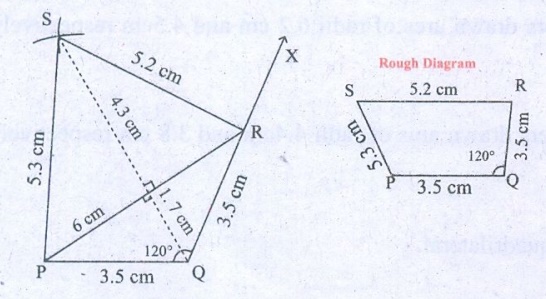
Steps:
1. Draw a line segment PQ = 3.5 cm
2. Made ∠Q = 120°. Drawn the ray QX.
3. With Q as centre drawn an arc of radius 3.5 cm. Let it cut
the ray QX at R.
4. With R and P as centres drawn arcs of radii 5.2 cm
respectively and let them cut at S.
5. Joined PS and RS.
6. PQRS is the required quadrilateral.
Calculation of Area:
Area of the quadrilateral PQRS  = 1/2 × d × (h1
+ h2) sq. units
= 1/2 × d × (h1
+ h2) sq. units
= 1/2 × 6 × (4.3 + 1.7) cm2
= 3 × 6 cm2
= 18 cm2
Area of the quadrilateral PQRS = 18 cm2
4. MIND, MI =3.6 cm, ND = 4 cm, MD= 4 cm, ∠M = 50° and ∠D = 100°.
Solution:
Given:
mi = 3.6 cm, ND = 4
cm, MD = 4 cm, ∠M = 50° and ∠D = 100°
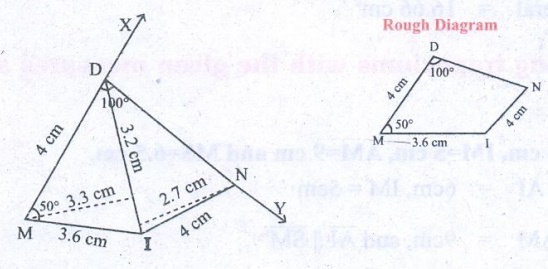
Steps:
1. Drawn a line segment MI = 3.6 cm
2. At M on MI made an angle ∠IMX = 50°
3. Drawn an arc with center M and radius 4 cm let it cut MX it D
4. At D on DM made an angle ∠MDY = 100°
5. With I as center drawn an arc of radius 4 cm, let it cut DY
at N.
6. Joined DN and IN.
7. MIND is the required quadrilateral.
Calculation of Area:
Area of the quadrilateral MIND  = 1/2 × d × (h1
+ h2) sq. units = 1/2 × 3.2 × (2.7 + 3.3) cm2
= 1/2 × d × (h1
+ h2) sq. units = 1/2 × 3.2 × (2.7 + 3.3) cm2
= 1/2 × 3.2 × 6 cm2 = 9.6 cm2
Area of the quadrilateral = 9.6 cm2
5. AGRI, AG= 4.5 cm, GR = 3.8 cm, ∠A =
60°, ∠G =
110° and ∠R =
90°.
Solution:
AG = 4.5 cm, GR = 3.8 cm, ∠A = 90°, ∠G = 110°, ∠R = 90°

Steps:
1. Draw a line segment AG = 4.5 cm
2. At G on AG made ∠AGX =110°
3. With G as centre drawn an arc of
radius 3.8 cm let it cut GX at R.
4. At R on GR made ∠GRZ = 90°
5. At A on AG made ∠GAY = 60°
6. AY and RZ meet at I.
7. AGRI is the required quadrilateral.
Calculation of Area:
Area of the quadrilateral AGRI  = 1/2 × d × (h1
+ h2) sq. units = 1/2 × 6.8 × (2.5 + 2.4) cm2
= 1/2 × d × (h1
+ h2) sq. units = 1/2 × 6.8 × (2.5 + 2.4) cm2
= 1/2 × 6.8 × 4.9 cm2 = 3.4 × 4.9 cm2
Area of the quadrilateral = 16.66 cm2
II. Construct the following trapeziums
with the given measures and also find their area.

1. AIMS with ̅A̅I̅ || S̅M̅, AI = 6 cm, IM = 5 cm, AM = 9 cm and MS = 6.5 cm.
Solution:
Given AI = 6cm, IM = 5cm
AM = 9cm, and A̅I̅ || S̅M̅
MS = 6.5 cm
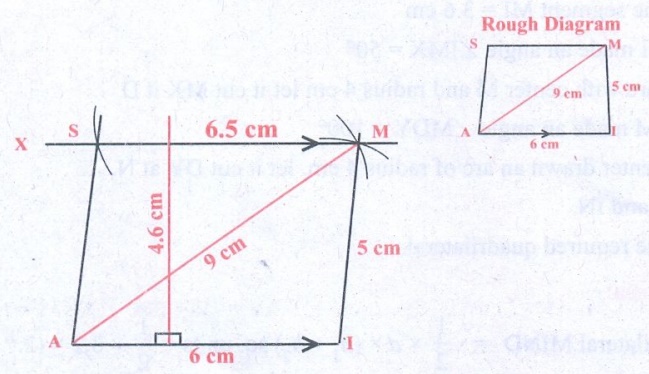
Construction :
Steps:
1. Draw a line segment AI = 6cm.
2. With A and I as centres, draw arcs of radii 9 cm and 5 cm
respectively and let them cut at M
3. Join AM and IM.
4. Draw MX parallel to AI
5. With M as centre, draw an arc of radius 6.5 cm cutting MX at
S.
6. Join AS AIMS is the required trapezium.
Calculation of Area:
Area of the trapezium AIMS  = 1/2 × h × (a + b)
sq.units
= 1/2 × h × (a + b)
sq.units
= 1/2 × 4.6 × (6 + 6.5)
= 1/2 × 4.6 × 12.5
= 28.75 Sq.cm
2. CUTE with C ̅U || ̅E̅T̅, CU = 7 cm, ∠UCE = 80°, CE = 6 cm and TE = 5 cm.
Solution:
Given : In the trapezium CUTE,
CU = 7cm, ∠UCE = 80°,
CE = 6 cm, TE = 5cm and C̅U̅ || E̅T̅
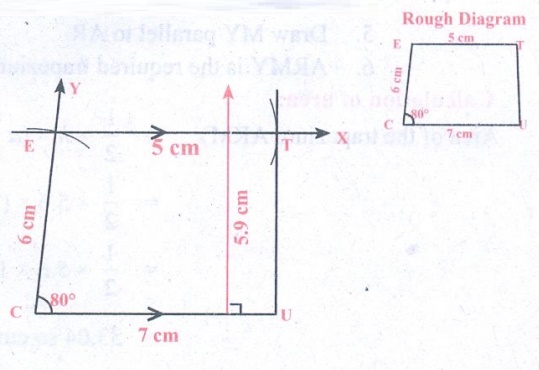
Construction:
Steps:
1. Draw a line segment CU = 7 cm.
2. Construct an angle ∠UCE = 80° at C
3. With C as centre, draw an arc 5 of radius 6 cm cutting CY at
E
4. Draw EX parallel to CU
5. With E as centre, draw an arc of radius 5 cm cutting EX at T
6. Join UT. CUTE is the required trapezium.
Calculation of area:
Area of the trapezium CUTE  = 1/2 × h × (a + b)
sq.units
= 1/2 × h × (a + b)
sq.units
= 1/2 × 5.9 × (7 + 5) sq.units
= 35.4 sq.cm
3.
ARMY with A ̅R || Y ̅M, AR = 7 cm, RM = 6.5 cm ∠RAY = 100° and ∠ARM = 60°
Solution:
Given :
In the trapezium ARMY
AR = 7 cm, RM = 6.5 cm,
∠RAY = 100° and ARM = 60°, A̅R̅ || Y̅M̅
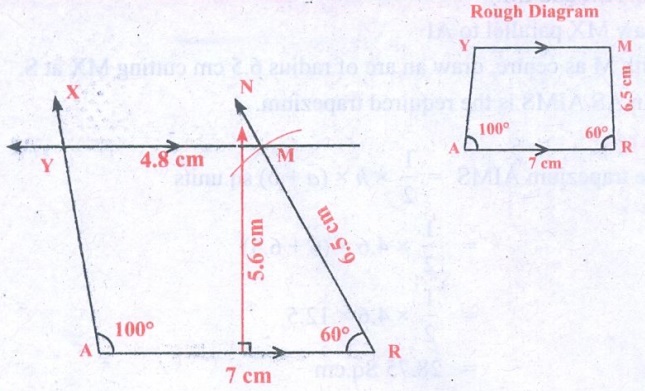
Construction:
Steps:
1. Draw a line segment AR = 7 cm.
2. Construct an angle ∠RAX = 100° at A
3. Construct an angle ∠ARN = 60° at R
4. With R as centre, draw an arc of radius 6.5 cm cutting RN at
M
5. Draw MY parallel to AR
6. ARMY is the required trapezium.
Calculation of area:
Area of the trapezium ARMY  = 1/2 × h × (a + b)
sq.units
= 1/2 × h × (a + b)
sq.units
= 1/2 × 5.6 × (7 + 4.8) sq.units
= 1/2 × 5.6 × 11.8
= 33.04 sq.cm
4. CITY with C ̅I || Y̅̅T, CI = 7 cm, IT = 5.5 cm, TY = 4 cm and YC = 6 cm.
Solution:
Given :
In the trapezium CITY,
CI = 7 cm, IT = 5.5 cm, TY = 4 cm
YC = 6 cm, and C̅I̅ || Y̅T̅
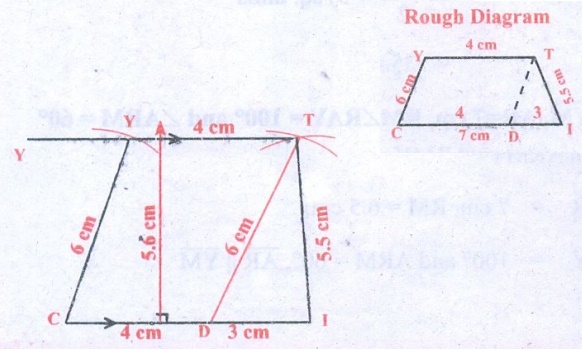
Construction:
Steps:
1. Draw a line segment CI = 7 cm.
2. Mark a point D on CI such that CD = 4 cm
3. With D and I as centres, draw arcs of radii 6 cm and 5.5 cm
respectively. Let them cut at T. join DT and IT.
4. With C as centre, draw an arc of radius 6 cm
5. Draw TY parallel to CI. Let the line cut the previous arc at Y.
6. Join CY. CITY is the required trapezium.
Calculation of area:
Area of the trapezium CITY  = 1/2 × h × (a + b)
sq.units
= 1/2 × h × (a + b)
sq.units
= 1/2 × 5.5 × (7 + 4) sq.units
= 1/2 × 5.5 × 11
= 30.25 sq.cm
Related Topics